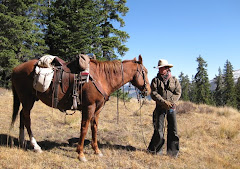
 This may not seem like much of a topic, but after remembering how stressed I’d be on the trail, right before arriving at camp, thinking about how to handle who and what first and how… I’ll hope I’m not the only one who might have appreciated a little advice on what you do when you get to the camp site.
This may not seem like much of a topic, but after remembering how stressed I’d be on the trail, right before arriving at camp, thinking about how to handle who and what first and how… I’ll hope I’m not the only one who might have appreciated a little advice on what you do when you get to the camp site.It’s this very reason that I’ve envied back packers (mind you, however, I am an avid and true blue horse packer). They arrive at camp, drop the load from their back, and sit back and rest a while. Then lay out their tent or bivy sack, heat up the water for their dehydrated dinner, and call it quits. OK, I don’t know if this makes up for the burden of carrying 70 pounds on your human back all day, but it’s the compromise. We horse packers don’t have the load, but once we get there, the work is far from over. (Oh, and in further defense of the horse packer – yes, you can tell I’ve been in this debate more than a few times – “sitting in the saddle” all day is far more than just sitting… Let me know what you think after you’ve spent 5 hours or so in the saddle in the mountains one day.)
So, what do we do when we arrive at camp?
Well, first of all, the horse comes first. And usually we have a few horses to care for. So, there’s work to be done.
When we arrive at a location we plan to set up camp, the horses need not be too close to camp. Remember, once they stop and relax, they’re more than likely to be needing to relieve themselves (probably the rider will be too), but no one needs that where you’ll be pitching your tent. We find a group of trees just far enough away from where we’ll be setting up camp that it’s easy to lead over the pack horses one at a time to unload, but odors will not be offensive.
Usually by the time we reach camp, the horses are tired and hungry (once again, probably the rider will be too). I stop, drop the lead rope of the pack string, drop the reins of my riding horse, and chances are more than likely that they’ll all do nothing more than lower their heads and begin to eat. As a probably obvious tip here, make sure you stop in a grassy location. The horses are more interested in eating and resting than running off. This gives me time to dismount, remove my horse’s headstall, hang it over the saddle horn, and clip on his lead rope; then take off my hat and chaps, which I usually just hang over my saddle; and untie the pack string.
Bringing the stallion to camp adds a little extra caution. I’ll drop his reins and let him graze, only long enough to remove his bridle, and clip on a long lead rope which I can picket to a stump or rock or bush if need be, to keep him at a safe distance from fighting with the other horses. But since he’s a skinny boy, I’d like him to be grazing as much as possible when he’s not working. You can use this trick if you have a horse that fights, bites, kicks, or runs off.
Then, each pack horse is led over closer to camp, and their load is lifted, unloaded under a big tree in a neat pile. Sometimes not so neat. But it’s all there. All the fixings for setting up camp in one big pile. We can take care of all that later. First, the horses. One by one, the horses are led over to a good sized fallen tree (in our neck of the woods, these are plentiful) that works as a great saddle rack. There, each horse is unsaddle, inspected for chafing, wound or saddle sores, briefly curried, and sprayed with fly spray if need be.
After each horse in unsaddled, they can either be tied to trees (high and tight) for a short period of time if this is permissible in your location, or better yet, set up your highline with tree savers (or cinches) right from the get go, and tie the horses safely up there.
The saddles are left uncovered to air out if it’s not raining, but we don’t forget to cover them before night fall, throwing one of the pack tarps over them to protect them from rain or snow, frost or dew.
After the last horse is unsaddled and tied up, we usually leave the horses tied and resting while we address the unpacking of the panniers and the setting up of camp. A little bit of down time for them won’t hurt, though we know what they really want is GRASS.
So, after camp is set and our personal belongings are all in order, before we can sit down and relax (or eat… and I’m usually pretty hungry by now, so keep those snacks handy), the horses have to be turned out to graze. I’ve address how we do this in a previous post.
When the horses are all turned out and grazing, and all stock seem well and fine, and the camp is set… then and only then can we sit and relax. But since we didn’t have to limit our gear to what we carry on our human back, and had our horses help instead, chances are we packed a chair, and now we’re sittin’ pretty!





